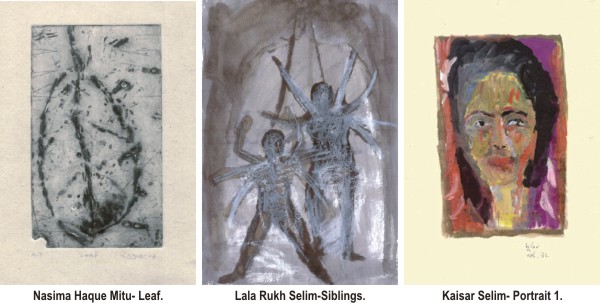Art
Tales of Sliding and Gliding Lines
Fayza Haq

Drawings involve drama, and one finds plenty of this in “Triad”, an exhibition of drawings by three artists at Galleri Kaya, which continuing till December 22. The work has been categorised as drawing as they are based on lines. The line is dominant even when colour is used in strokes, patches or for filling up space. The similarity in the works of the three participants is traceable in their interest in figurative imagery. Lala Rukh Selim, an Associate Professor of Sculpture of Dhaka University and one of the artists, says, "We are calling them drawings as they are based on the lines. Mine include figures of women and deities, although not of any specific ones. We had not originally made our drawings to be exhibited. They are very personal expressions. The similarity between our works is the interest in primal and essential aspects of humanity and nature."
Lala Rukh has always found drawing a self-sufficient form. She has a deep enthusiasm for the culture of this region. Her work is a combination of her training in westernised art education and a personal search for local tradition. She has striven to assimilate local forms and concepts in her work. Her theoretical ventures have also focuses on tradition, women and society.
Kaisar Selim, a self-taught artist, deals with the sensory aspects of human beings. Basically a writer, he does portraits, which are very expressive and go beyond the surface, reflecting his unusual vision. They use the expressive qualities of colour, bringing depth through layers of colour. His ritual dances are also fascinating, his figures being stylised and expressive. When writing fails him in describing he expresses his feelings and thoughts through his drawings. In all his works he reaches out to the fundamentals of human expressions and senses. In some of his work we see the ordinary but even in this an element of mystery is found.
Nasima Haque Mitu, a teacher of art of the indigenous people of Africa, the Americas, Oceania and Australia, showcases work done in the print media but they are based on line, showing an obsession for the traditional. She says, "My drawings express the joy that I get when proceeding with my work. My perspectives deal with historical and social relationships such as that between a child and its mother. The exhibits here are simple, spontaneous but significant. They are executed in the process of working directly on a printmaking plate, without dwelling on preliminary sketches.
In depicting Buddha on a second exhibit, Mitu has concentrated on the lower section of the statue in order to focus on the position of the feet and the hands, which is totally eastern and unique. The human anatomy is given a distinctive direction and shape. Lines are persistently drawn on the metal plates on which she has worked for her print pieces. Mitu has been taught by Hamiduzzaman Khan and Abdur Razzaque. As a teacher she enjoys suggesting ideas to the young learners who enter the art world.
Copyright
(R) thedailystar.net 2009 |
